UPLC-ESI-MS/MS Profiling and Cytotoxic, Antioxidant, Anti-Inflammatory, Antidiabetic, and Antiobesity Activities of the Non-Polar Fractions of Salvia hispanica L. Aerial Parts
Abstract
1. Introduction
2. Results and Discussion
2.1. Structural Identification of Constituents by UPLC-ESI-MS/MS
2.2. Isolated Compounds from the Light Petroleum Fraction
2.3. GLC-MS Analysis of Seeds Oil
2.4. Cytotoxic Activity
2.5. Antioxidant Activity
2.6. Anti-Inflammatory Activity
2.7. Antidiabetic Activity
2.8. Antiobesity Activity
3. Material and Methods
3.1. Instruments for Spectroscopic Analyses
3.2. Plant Material
3.3. Extract Preparation
3.4. Chromatographic Investigations
3.5. LC/MS Instrument and Separation Technique
3.6. GLC-MS of Salvia Seeds’ Oil
3.7. Cytotoxic Activity
3.8. Antioxidant Activity
3.9. Anti-Inflammatory Activity
3.10. Antidiabetic Activity
3.11. Antiobesity Activity
4. Conclusions
Author Contributions
Funding
Institutional Review Board Statement
Informed Consent Statement
Data Availability Statement
Acknowledgments
Conflicts of Interest
References
- Abdelkader, M.; Ahcen, B.; Rachid, D.; Hakim, H. Phytochemical study and biological activity of sage (Salvia officinalis L.). Int. J. Bioeng. Life Sci. 2014, 8, 1231–1235. [Google Scholar]
- Rama Rao, V.; Shiddamallayya, N.; Kavya, N.; Kavya, B.; Venkateshwarlu, G. Diversity and therapeutic potentiality of the family lamiaceae in karnataka state, india: An overview. History 2015, 13, 6–14. [Google Scholar]
- Ayerza, R.; Coates, W. Chia: Rediscovering a Forgotten Crop of the Aztecs; University of Arizona Press: Tucson, AZ, USA, 2005. [Google Scholar]
- Taga, M.S.; Miller, E.E.; Pratt, D.E. Chia seeds as a source of natural lipid antioxidants. J. Am. Oil Chem. Soc. 1984, 61, 928–931. [Google Scholar] [CrossRef]
- Mohd Ali, N.; Yeap, S.K.; Ho, W.Y.; Beh, B.K.; Tan, S.W.; Tan, S.G. The promising future of chia, Salvia hispanica L. J. Biomed. Biotechnol. 2012, 2012, 171956. [Google Scholar] [CrossRef] [PubMed]
- Rahman, M.J.; de Camargo, A.C.; Shahidi, F. Phenolic and polyphenolic profiles of chia seeds and their in vitro biological activities. J. Funct. Foods 2017, 35, 622–634. [Google Scholar] [CrossRef]
- de Falco, B.; Amato, M.; Lanzotti, V. Chia seeds products: An overview. Phytochem. Rev. 2017, 16, 745–760. [Google Scholar] [CrossRef]
- Oliveira-Alves, S.C.; Vendramini-Costa, D.B.; BetimCazarin, C.B.; Maróstica Júnior, M.R.; Borges Ferreira, J.P.; Silva, A.B.; Prado, M.A.; Bronze, M.R. Characterization of phenolic compounds in chia (Salvia hispanica L.) seeds, fiber flour and oil. Food Chem. 2017, 232, 295–305. [Google Scholar] [CrossRef]
- Abdel-Aty, A.M.; Elsayed, A.M.; Salah, H.A.; Bassuiny, R.I.; Mohamed, S.A. Egyptian chia seeds (Salvia hispanica L.) during germination: Upgrading of phenolic profile, antioxidant, antibacterial properties and relevant enzymes activities. Food Sci. Biotechnol. 2021, 30, 723–734. [Google Scholar] [CrossRef]
- Tavares Toscano, L.; Tavares Toscano, L.; Leite Tavares, R.; da Oliveira Silva, C.S.; Silva, A.S. Chia induces clinically discrete weight loss and improves lipid profile only in altered previous values. Nutr. Hosp. 2014, 31, 1176–1182. [Google Scholar]
- da Silva, B.P.; Dias, D.M.; de Castro Moreira, M.E.; Toledo, R.C.; da Matta, S.L.; Lucia, C.M.; Martino, H.S.; Pinheiro-Sant’Ana, H.M. Chia Seed Shows Good Protein Quality, Hypoglycemic Effect and Improves the Lipid Profile and Liver and Intestinal Morphology of Wistar Rats. Plant Foods Hum. Nutr. 2016, 71, 225–230. [Google Scholar] [CrossRef]
- Vuksan, V.; Jenkins, A.; Brissette, C.; Choleva, L.; Jovanovski, E.; Gibbs, A.L.; Bazinet, R.P.; Au-Yeung, F.; Zurbau, A.; Ho, H.V.; et al. Salba-chia (Salvia hispanica L.) in the treatment of overweight and obese patients with type 2 diabetes: A double-blind randomized controlled trial. Nutr. Metab. Cardiovasc. Dis. 2017, 27, 138–146. [Google Scholar] [CrossRef] [PubMed]
- Elshafie, H.S.; Aliberti, L.; Amato, M.; De Feo, V.; Camele, I. Chemical composition and antimicrobial activity of chia (Salvia hispanica L.) essential oil. Eur. Food Res. Technol. 2018, 244, 1675–1682. [Google Scholar] [CrossRef]
- Fan, M.; Luo, D.; Peng, L.Y.; Li, X.N.; Wu, X.D.; Ji, X.; Zhao, Q.S. Neo-clerodane diterpenoids from aerial parts of Salvia hispanica L. and their cardioprotective effects. Phytochemistry 2019, 166, 112065. [Google Scholar] [CrossRef] [PubMed]
- Fan, M.; Luo, D.; Peng, L.Y.; Wu, X.D.; Ji, X.; Zhao, Q.S. Rearranged neoclerodane diterpenoids from the aerial parts of Salvia hispanica L. Fitoterapia 2020, 146, 104672. [Google Scholar] [CrossRef] [PubMed]
- Amato, M.; Caruso, M.C.; Guzzo, F.; Galgano, F.; Commisso, M.; Bochicchio, R.; Labella, R.; Favati, F. Nutritional quality of seeds and leaf metabolites of Chia (Salvia hispanica L.) from Southern Italy. Eur. Food Res. Technol. 2015, 241, 615–625. [Google Scholar] [CrossRef]
- Abou Zeid, E.M.; Ghani, A.E.A.; Mahmoud, M.Y.; Abdallah, R.H. Phytochemical investigation and biological screening of ethyl acetate fraction of Salvia hispanica L. Aerial parts. Pharmacogn. J. 2022, 14, 226–234. [Google Scholar] [CrossRef]
- López-Salazar, H.; Camacho-Díaz, B.H.; Ávila-Reyes, S.V.; Pérez-García, M.D.; González-Cortazar, M.; Arenas Ocampo, M.L.; Jiménez-Aparicio, A.R. Identification and quantification of β-sitosterol β-d-glucoside of an ethanolic extract obtained by microwave-assisted extraction from Agave angustifolia haw. Molecules 2019, 24, 3926. [Google Scholar] [CrossRef]
- Zhou, Y.; Xu, G.; Choi, F.F.K.; Ding, L.-S.; Han, Q.B.; Song, J.Z.; Qiao, C.F.; Zhao, Q.-S.; Xu, H.-X. Qualitative and quantitative analysis of diterpenoids in salvia species by liquid chromatography coupled with electrospray ionization quadrupole time-of-flight tandem mass spectrometry. J. Chromatogr. A 2009, 1216, 4847–4858. [Google Scholar] [CrossRef]
- Haq, F.U.; Ali, A.; Akhtar, N.; Aziz, N.; Khan, M.N.; Ahmad, M.; Musharraf, S.G. A high-throughput method for dereplication and assessment of metabolite distribution in salvia species using lc-ms/ms. J. Adv. Res. 2020, 24, 79–90. [Google Scholar] [CrossRef]
- Zhang, W.; Abdel-Rahman, F.H.; Saleh, M.A. Natural resistance of rose petals to microbial attack. J. Environ. Sci. Health B 2011, 46, 381–393. [Google Scholar] [CrossRef]
- Yang, S.; Wu, X.; Rui, W.; Guo, J.; Feng, Y. Uplc/q-tof-ms analysis for identification of hydrophilic phenolics and lipophilic diterpenoids from Radix salviae miltiorrhizae. Acta Chromatogr. 2015, 27, 711–728. [Google Scholar] [CrossRef]
- Ayatollahi, A.M.; Ghanadian, M.; Afsharypour, S.; Abdella, O.M.; Mirzai, M.; Askari, G. Pentacyclic triterpenes in Euphorbia microsciadia with their t-cell proliferation activity. Iran J. Pharm. Res. 2011, 10, 287–294. [Google Scholar] [PubMed]
- Thanakijcharoenpath, W.; Theanphong, O. Triterpenoids from the stem of Diospyros glandulosa. Thai J. Pharm. Sci. 2007, 31, 1–8. [Google Scholar]
- Echiburu-Chau, C.; Pastén, L.; Parra, C.; Bórquez, J.; Mocan, A.; Simirgiotis, M.J. High resolution uhplc-ms characterization and isolation of main compounds from the antioxidant medicinal plant Parastrephia lucida (meyen). Saudi Pharm. J. 2017, 25, 1032–1039. [Google Scholar] [CrossRef]
- Gong, L.; Haiyu, X.; Wang, L.; Xiaojie, Y.; Huijun, Y.; Songsong, W.; Cheng, L.; Ma, X.; Gao, S.; Liang, R. Identification and evaluation of the chemical similarity of yindanxinnaotong samples by ultra high performance liquid chromatography with quadrupole time-of-flight mass spectrometry fingerprinting. J. Sep. Sci. 2016, 39, 611–622. [Google Scholar] [CrossRef]
- Kumar, S.; Singh, A.; Kumar, B. Identification and characterization of phenolics and terpenoids from ethanolic extracts of Phyllanthus species by hplc-esi-qtof-ms/ms. J. Pharm. Anal. 2017, 7, 214–222. [Google Scholar] [CrossRef]
- Jiao, Q.-S.; Xu, L.-L.; Zhang, J.-Y.; Wang, Z.-J.; Jiang, Y.-Y.; Liu, B. Rapid characterization and identification of non-diterpenoid constituents in Tinospora sinensis by hplc-ltq-orbitrap msn. Molecules 2018, 23, 274. [Google Scholar] [CrossRef]
- Barros, L.; Dueñas, M.; Pinela, J.; Carvalho, A.M.; Buelga, C.S.; Ferreira, I.C. Characterization and quantification of phenolic compounds in four tomatoes (Lycopersicon esculentum L.) farmers’ varieties in northeastern portugalhomegardens. Plant Foods Hum. Nutr. 2012, 67, 229–234. [Google Scholar] [CrossRef]
- Chandrasekara, A.; Shahidi, F. Determination of antioxidant activity in free and hydrolyzed fractions of millet grains and characterization of their phenolic profiles by hplc-dad-esi-msn. J. Funct. Foods 2011, 3, 144–158. [Google Scholar] [CrossRef]
- Jong, T.-T.; Lee, M.-R.; Chiang, Y.-C.; Chiang, S.-T. Using lc/ms/ms to determine matrine, oxymatrine, ferulic acid, mangiferin, and glycyrrhizin in the chinese medicinal preparations shiau-feng-saan and dang-guei-nian-tong-tang. J. Pharm. Biomed. Anal. 2006, 40, 472–477. [Google Scholar] [CrossRef]
- Park, J.B. Isolation and characterization of N-feruloyltyramine as the P-selectin expression suppressor from garlic (Allium sativum). J. Agric. Food Chem. 2009, 57, 8868–8872. [Google Scholar] [CrossRef] [PubMed]
- Ożarowski, M.; Piasecka, A.; Gryszczyńska, A.; Sawikowska, A.; Pietrowiak, A.; Opala, B.; Mikołajczak, P.Ł.; Kujawski, R.; Kachlicki, P.; Buchwald, W. Determination of phenolic compounds and diterpenes in roots of Salvia miltiorrhiza and Salvia przewalskii by two lc–ms tools: Multi-stage and high resolution tandem mass spectrometry with assessment of antioxidant capacity. Phytochem. Lett. 2017, 20, 331–338. [Google Scholar] [CrossRef]
- Tian, D.; Yang, Y.; Yu, M.; Han, Z.-Z.; Wei, M.; Zhang, H.-W.; Jia, H.-M.; Zou, Z.-M. Anti-inflammatory chemical constituents of flos Chrysanthemiindici determined by uplc-ms/ms integrated with network pharmacology. Food Funct. 2020, 11, 6340–6351. [Google Scholar] [CrossRef]
- Yang, M.; Liu, A.; Guan, S.; Sun, J.; Xu, M.; Guo, D. Characterization of tanshinones in the roots of Salvia miltiorrhiza (dan-shen) by high-performance liquid chromatography with electrospray ionization tandem mass spectrometry. Rapid Commun. Mass Spectrom. 2006, 20, 1266–1280. [Google Scholar] [CrossRef] [PubMed]
- Nadeem, M.; Mumtaz, M.W.; Danish, M.; Rashid, U.; Mukhtar, H.; Irfan, A. Antidiabetic functionality of Vitex negundo L. Leaves based on uhplc-qtof-ms/ms based bioactives profiling and molecular docking insights. Ind. Crops Prod. 2020, 152, 112445. [Google Scholar] [CrossRef]
- Musharraf, S.G.; Goher, M.; Hussain, A.; Choudhary, M.I. Electrospray tandem mass spectrometric analysis of a dimeric conjugate, salvialeriafone and related compounds. Chem. Cent. J. 2012, 6, 120. [Google Scholar] [CrossRef] [PubMed]
- Boukhalkhal, S.; Gourine, N.; Pinto, D.C.; Silva, A.M.; Yousfi, M. Uhplc-dad-esi-msn profiling variability of the phenolic constituents of Artemisia campestris L. Populations growing in algeria. Biocatal. Agric. Biotechnol. 2020, 23, 101483. [Google Scholar] [CrossRef]
- Bielecka, M.; Pencakowski, B.; Stafiniak, M.; Jakubowski, K.; Rahimmalek, M.; Gharibi, S.; Matkowski, A.; Ślusarczyk, S. Metabolomics and DNA-based authentication of two traditional asian medicinal and aromatic species of Salvia subg. Perovskia. Cells 2021, 10, 112. [Google Scholar] [CrossRef]
- Jesionek, W.; Majer-Dziedzic, B.; Horváth, G.; Móricz, Á.M.; Choma, I.M. Screening of antibacterial compounds in Salvia officinalis L. Tincture using thin-layer chromatography—Direct bioautography and liquid chromatography—Tandem mass spectrometry techniques. JPC-J. Plan. Chroma.-Mod. TLC 2017, 30, 357–362. [Google Scholar] [CrossRef]
- Lee, S.-H.; Kim, H.-W.; Lee, M.-K.; Kim, Y.J.; Asamenew, G.; Cha, Y.-S.; Kim, J.-B. Phenolic profiling and quantitative determination of common sage (Salvia plebeia r. Br.) by uplc-dad-qtof/ms. Eur. Food Res. Technol. 2018, 244, 1637–1646. [Google Scholar] [CrossRef]
- Gattuso, G.; Caristi, C.; Gargiulli, C.; Bellocco, E.; Toscano, G.; Leuzzi, U. Flavonoid glycosides in bergamot juice (Citrus bergamia risso). J. Agric. Food Chem. 2006, 54, 3929–3935. [Google Scholar] [CrossRef] [PubMed]
- Ben Said, R.; Hamed, A.I.; Mahalel, U.A.; Al-Ayed, A.S.; Kowalczyk, M.; Moldoch, J.; Oleszek, W.; Stochmal, A. Tentative characterization of polyphenolic compounds in the male flowers of Phoenix dactylifera by liquid chromatography coupled with mass spectrometry and DFT. Int. J. Mol. Sci. 2017, 18, 512. [Google Scholar] [CrossRef]
- Spínola, V.; Llorent-Martínez, E.J.; Gouveia, S.; Castilho, P.C. Myrica faya: A new source of antioxidant phytochemicals. J. Agric. Food Chem. 2014, 62, 9722–9735. [Google Scholar] [CrossRef] [PubMed]
- Jassbi, A.R.; Zare, S.; Firuzi, O.; Xiao, J. Bioactive phytochemicals from shoots and roots of Salvia species. Phytochem. Rev. 2016, 15, 829–867. [Google Scholar] [CrossRef]
- Ododo, M.M.; Choudhury, M.K.; Dekebo, A.H. Structure elucidation of β-sitosterol with antibacterial activity from the root bark of Malva parviflora. SpringerPlus 2016, 5, 1–11. [Google Scholar] [CrossRef] [PubMed]
- Oladosu, I.; Lawson, L.; Aiyelaagbe, O.; Emenyonu, N.; Afieroho, O. Anti-tuberculosis lupane-type isoprenoids from syzygiumguineense wild dc. (myrtaceae) stem bark. Future J. Pharm. Sci. 2017, 3, 148–152. [Google Scholar] [CrossRef]
- Martins, D.; Carrion, L.L.; Ramos, D.F.; Salomé, K.S.; da Silva, P.E.A.; Barison, A.; Nunez, C.V. Triterpenes and the antimycobacterial activity of Duroia macrophylla huber (rubiaceae). BioMed Res. Int. 2013, 2013, 605831. [Google Scholar] [CrossRef]
- Faizi, S.; Ali, M.; Saleem, R.; Bibi, S. Complete 1H and 13C nmr assignments of stigma-5-en-3-o-β-glucoside and its acetyl derivative. Magn. Reson. Chem. 2001, 39, 399–405. [Google Scholar] [CrossRef]
- Muthusami, V.K.G. Dietary evaluation, antioxidant and cytotoxic activity of crude extract from chia seeds (Salvia hispanica L.) against human prostate cancer cell line (pc-3). Int. J. Pharmacogn. Phytochem. Res. 2016, 8, 1358–1362. [Google Scholar]
- Pourmorad, F.; Hosseinimehr, S.; Shahabimajd, N. Antioxidant activity, phenol and flavonoid contents of some selected iranian medicinal plants. Afr. J. Biotechnol. 2006, 5, 1142–1145. [Google Scholar]
- Tran, Q.T.; Wong, W.F.; Chai, C.L. Labdane diterpenoids as potential anti-inflammatory agents. Pharmacol. Res. 2017, 124, 43–63. [Google Scholar] [CrossRef]
- Chaniad, P.; Sudsai, T.; Septama, A.W.; Chukaew, A.; Tewtrakul, S. Evaluation of anti-HIV-1 integrase and anti-inflammatory activities of compounds from Betula alnoides buch-ham. Adv. Pharmacol. Sci. 2019, 2019, 2573965. [Google Scholar]
- Devarshi, P.P.; Jangale, N.M.; Ghule, A.E.; Bodhankar, S.L.; Harsulkar, A.M. Beneficial effects of flaxseed oil and fish oil diet are through modulation of different hepatic genes involved in lipid metabolism in streptozotocin–nicotinamide induced diabetic rats. Genes Nutr. 2013, 8, 329–342. [Google Scholar] [CrossRef]
- Nakai, M.; Fukui, Y.; Asami, S.; Toyoda-Ono, Y.; Iwashita, T.; Shibata, H.; Mitsunaga, T.; Hashimoto, F.; Kiso, Y. Inhibitory effects of oolong tea polyphenols on pancreatic lipasein vitro. J. Agric. Food Chem. 2005, 53, 4593–4598. [Google Scholar] [CrossRef] [PubMed]
- Ixtaina, V.Y.; Martínez, M.L.; Spotorno, V.; Mateo, C.M.; Maestri, D.M.; Diehl, B.W.; Nolasco, S.M.; Tomás, M.C. Characterization of chia seed oils obtained by pressing and solvent extraction. J. Food Compos. Anal. 2011, 24, 166–174. [Google Scholar] [CrossRef]
- Metcalfe, L.; Schmitz, A. The rapid preparation of fatty acid esters for gas chromatographic analysis. Anal. Chem. 1961, 33, 363–364. [Google Scholar] [CrossRef]
- Mosmann, T. Rapid colorimetric assay for cellular growth and survival: Application to proliferation and cytotoxicity assays. J. Immunol. Methods 1983, 65, 55–63. [Google Scholar] [CrossRef]
- Abdelglil, M.I.; Abdallah, S.O.; El-Desouky, M.A.; Alfaifi, M.Y.; Elbehairi, S.E.I.; Mohamed, A.F. Evaluation of the Anticancer Potential of Crude, Irradiated Cerastes cerastes Snake Venom and Propolis Ethanolic Extract & Related Biological Alterations. Molecules 2021, 26, 7057. [Google Scholar] [PubMed]
- El-Seadawy, H.M.; Abo El-Seoud, K.A.; El-Aasr, M.; Tawfik, H.O.; Eldehna, W.M.; Ragab, A.E. Evaluation of Zamia floridana A. DC. Leaves and Its Isolated Secondary Metabolites as Natural Anti-Toxoplasma and Anti-Cancer Agents Using In Vitro and In Silico Studies. Metabolites 2022, 13, 10. [Google Scholar] [CrossRef]
- Leaves, L.; Leaves, L. Antioxidant activity by dpph radical scavenging method of Ageratum conyzoides. Am. J. Ethnomed. 2014, 1, 244–249. [Google Scholar]
- Venkata, M.; Sripathy, R.; Anjana, D.; Somashekara, N.; Krishnaraju, A.; Krishanu, S.; Murali, M.; Verma, S.R.; Ramchand, C. In silico, in vitro and in vivo assessment of safety and anti-inflammatory activity of curcumin. Am. J. Infect. Dis. 2012, 8, 26. [Google Scholar]
- Narkhede, M.; Ajimire, P.; Wagh, A.; Mohan, M.; Shivashanmugam, A. In vitro antidiabetic activity of Caesalpinadigyna (r.) methanol root extract. Asian J. Plant Sci. Res. 2011, 1, 101–106. [Google Scholar]
- Kim, Y.S.; Lee, Y.M.; Kim, H.; Kim, J.; Jang, D.S.; Kim, J.H.; Kim, J.S. Anti-obesity effect of Morus bombycis root extract: Anti-lipase activity and lipolytic effect. J. Ethnopharmacol. 2010, 130, 621–624. [Google Scholar] [CrossRef] [PubMed]
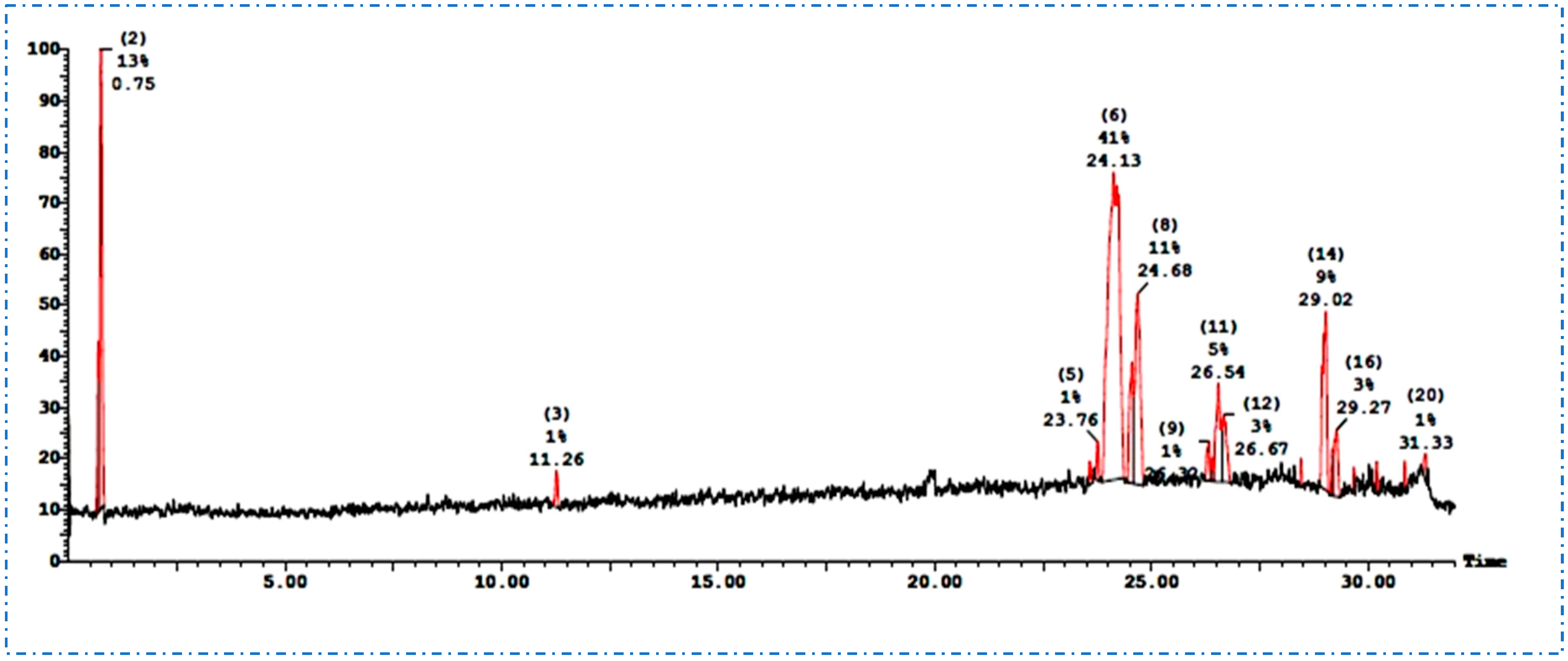
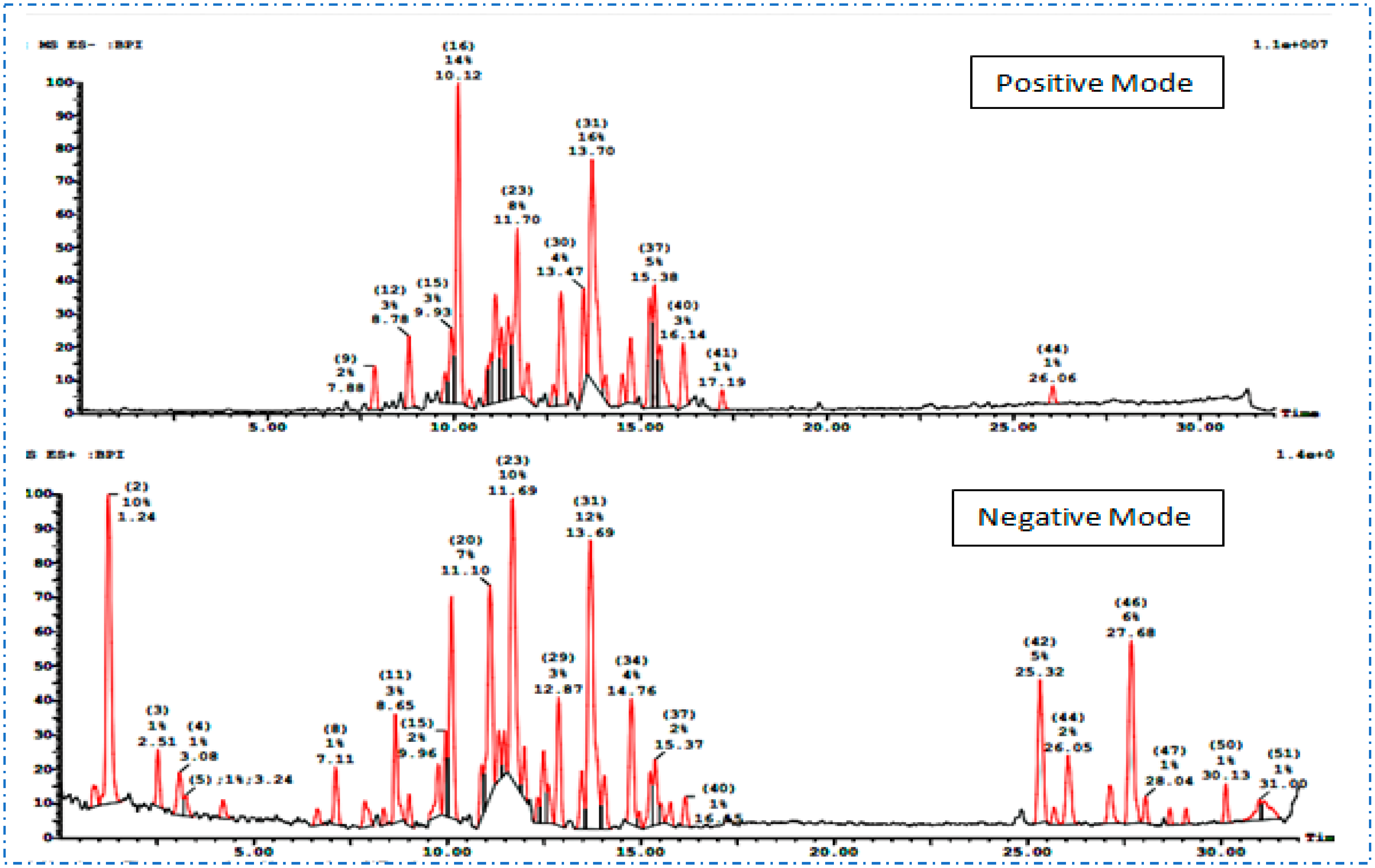
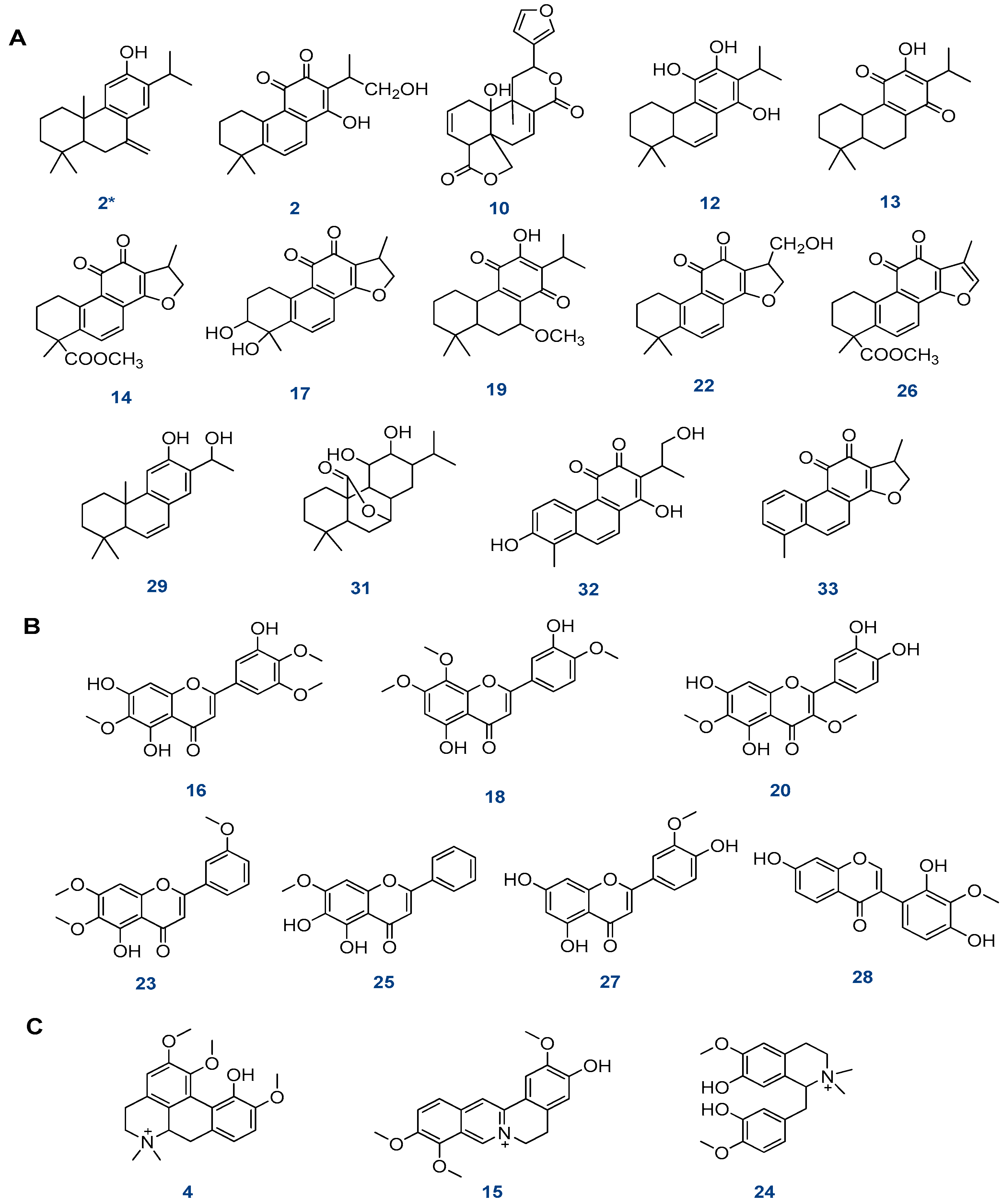
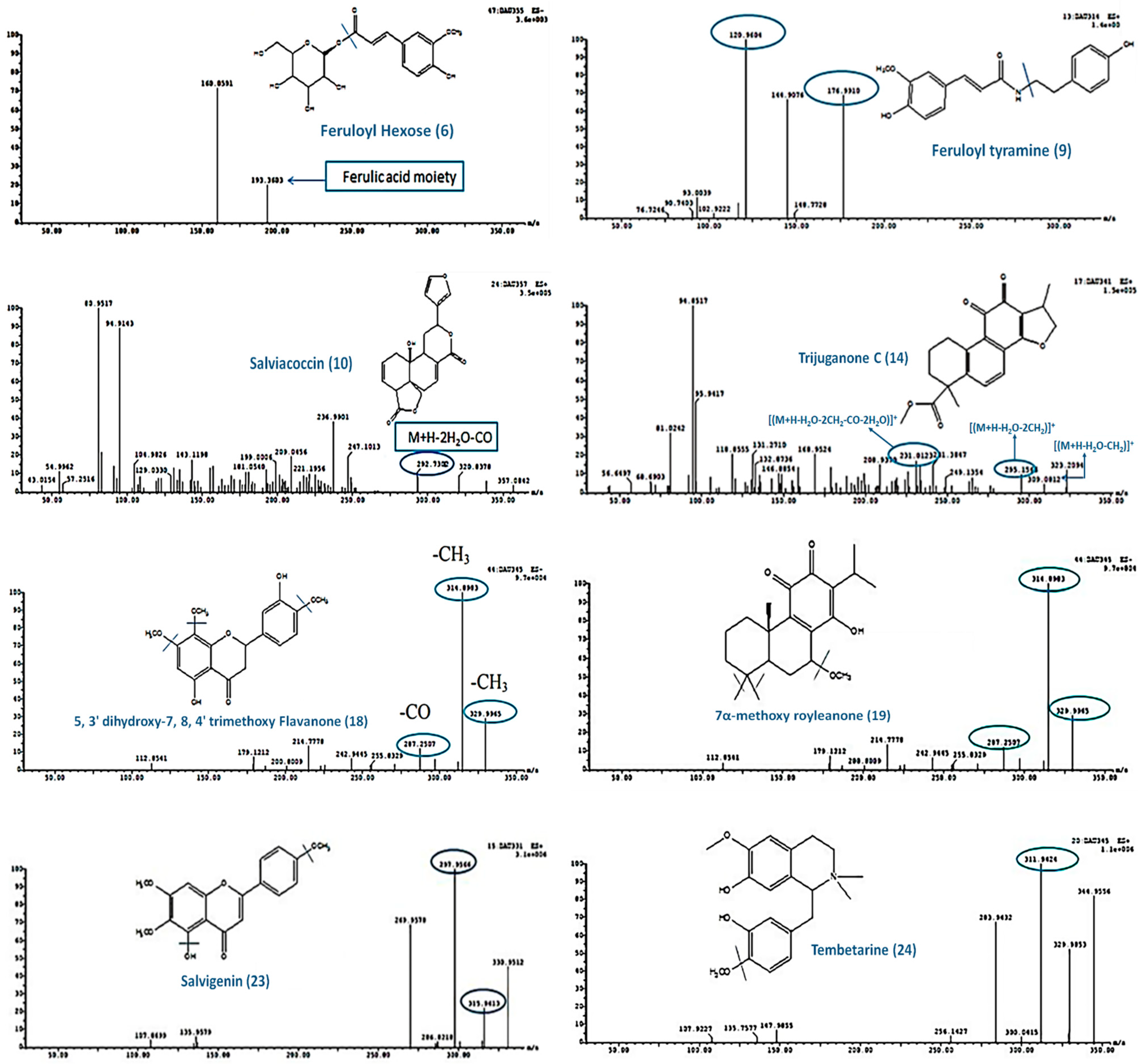
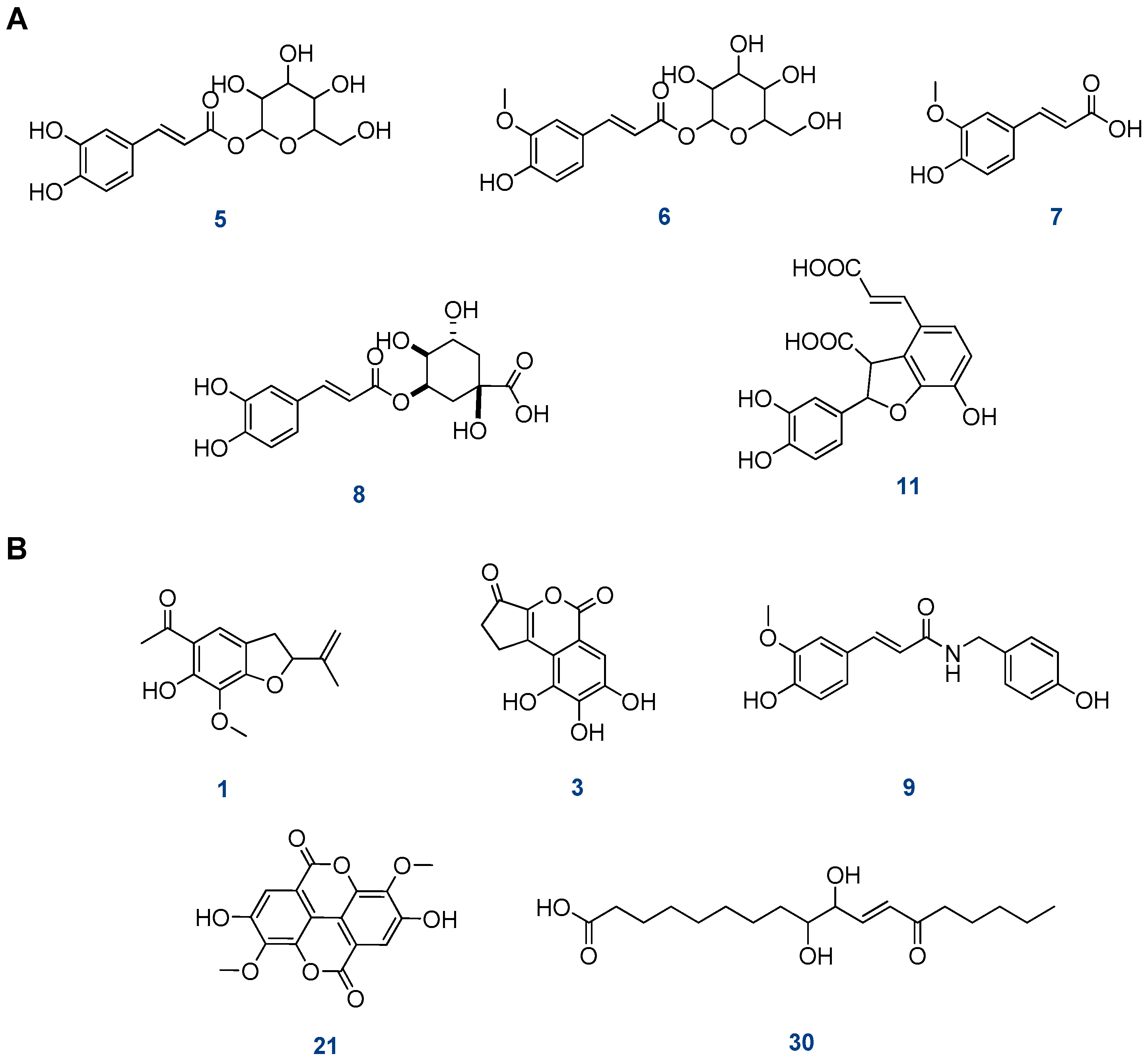
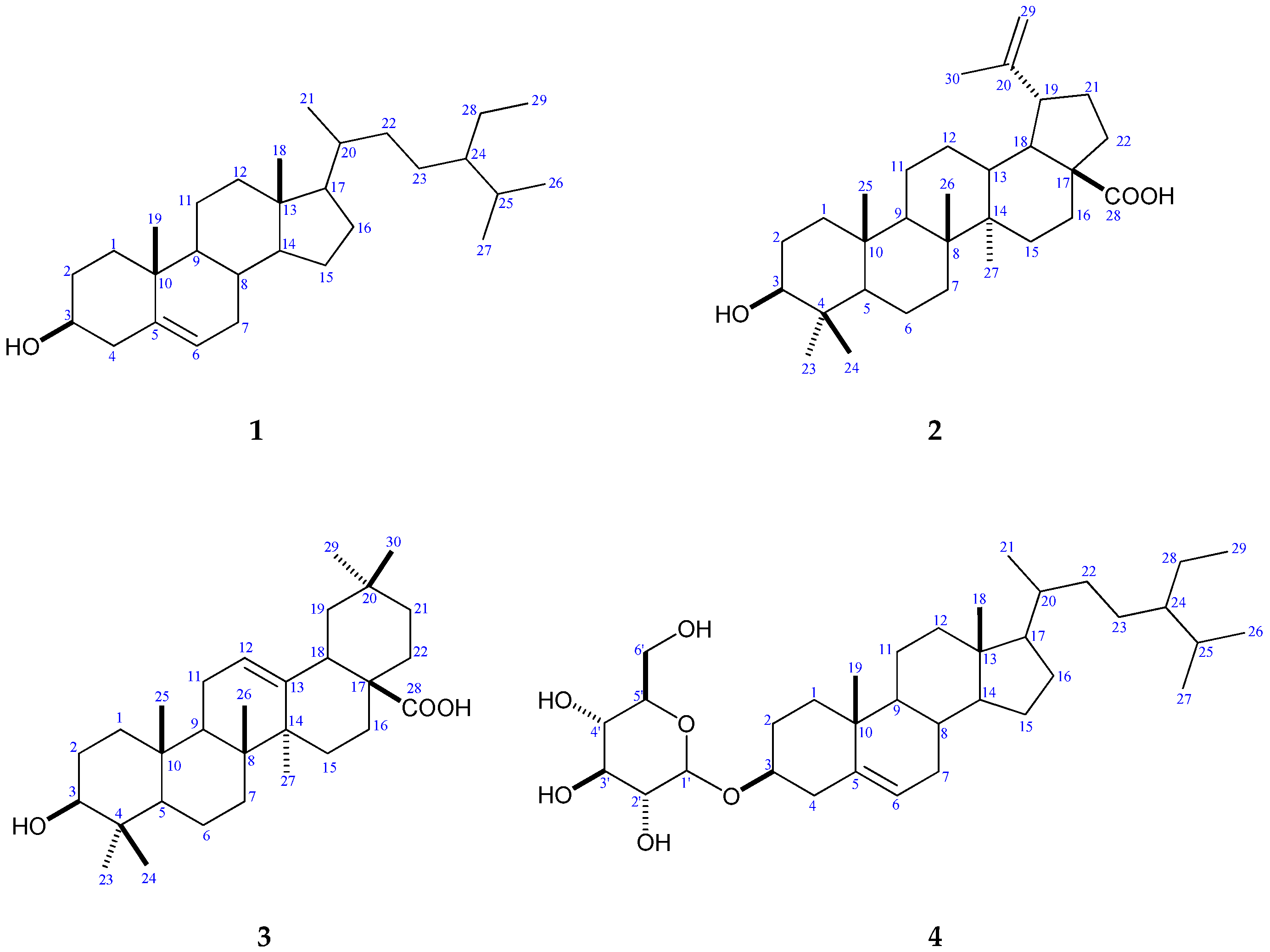
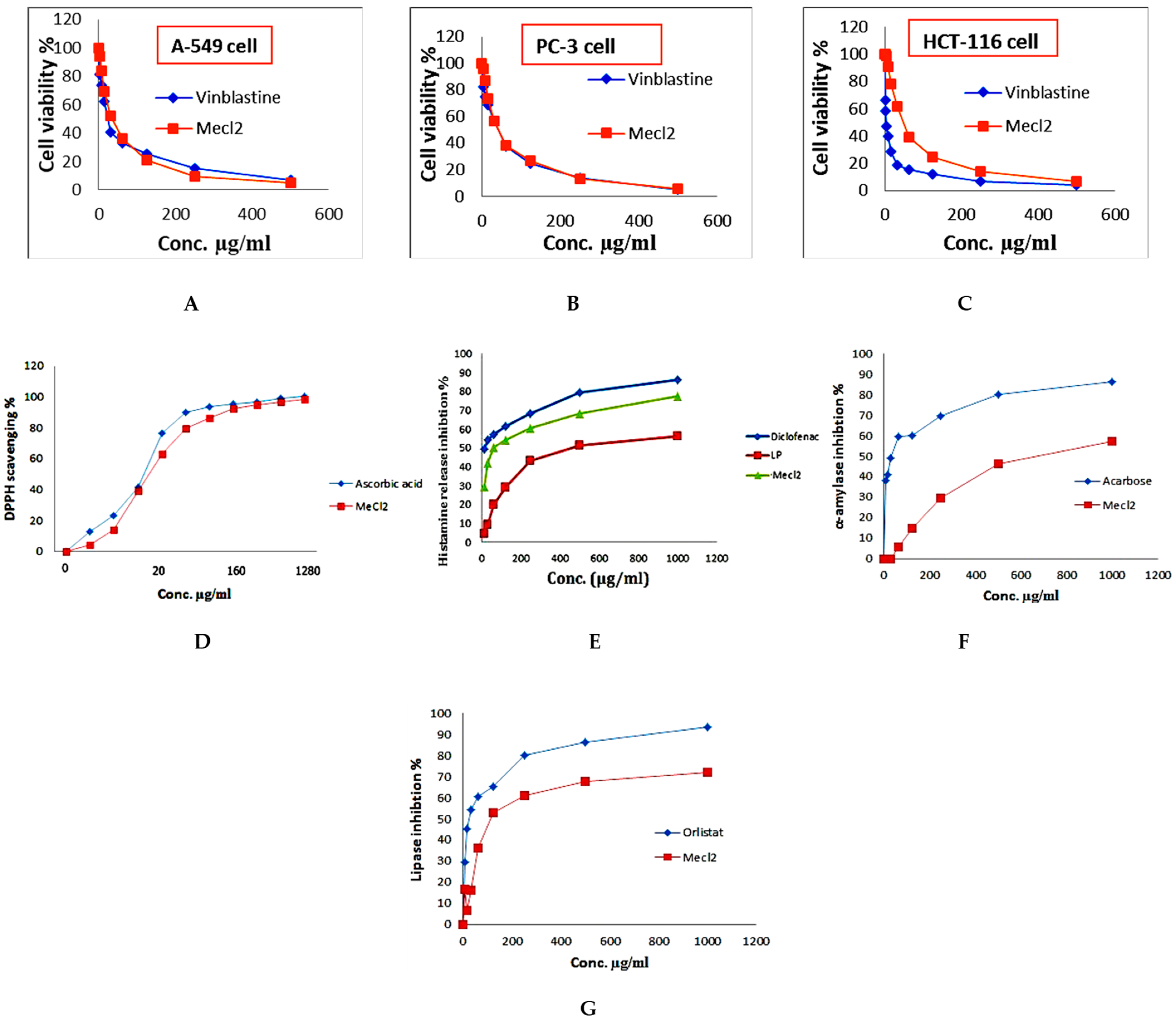
| No. | Type | Rt | M+ | [M+H]+ | MS2 Fragments | Compound Name | Ref. |
|---|---|---|---|---|---|---|---|
| 1 | Steroid | 23.57 | 576 | 577 | 415,267,211 | β-sitosterol-O-glucoside | [18] |
| 2 | Diterpene | 23.76 | 300 | 301 | 227 | Sugiol | [19] |
| 3 | Triterpenoid | 23.77 | 278 | 279 | 301,279,261 | 7α-hydroxy-14,15-dinorlabd-8(17)-en-13-one | [20] |
| 4 | Steroid | 24.13 | 414 | 415 | 414,396,381 | β-sitosterol | [21] |
| 5 | Fatty acid | 24.68 | 280 | 281 | - | Linoleic acid | [22] |
| 6 | Fatty acid | 26.54 | 278 | 279 | - | Linolenic acid | [22] |
| 7 | Triterpenoid | 29.68 | 456 | 457 | 248,207,203,189,175 | Betulinic acid | [23] |
| 8 | Triterpenoid | 29.68 | 456 | 457 | 248,207,203,189 | Oleanolic acid | [24] |
| 9 | Fatty acid | 29.69 | 256 | 257 | - | Palmitic acid | [22] |
| No. | Type | Rt | M+ | [M-H]− | [M+H]+ | MS2 Fragments | Compound Name | Ref. |
|---|---|---|---|---|---|---|---|---|
| 1 | Tremetone | 6.39 | 248 | 249 | 137 | 6-hydroxy-7-methoxy Tremetone | [25] | |
| 2 | Diterpene | 7.26 | 316 | 317 | 299,267 | Tanshinone V | [26] | |
| 3 | Coumarin | 7.87 | 248 | 249 | 193,175 | Brevifolin | [27] | |
| 4 | Alkaloid | 8.82 | 356 | 357 | 311 | Menisperine | [28] | |
| 5 | Phenolic acid | 9.00 | 342 | 343 | 181 | Caffeic acid hexoside | [29] | |
| 6 | Phenolic acid | 9.12 | 356 | 355 | 193,160 | Feruloyl hexose | [30] | |
| 7 | Phenolic acid | 9.96 | 194 | 195 | 180,177,136 | Ferulic acid | [31] | |
| 8 | Phenolic acid | 10.16 | 354 | 353 | 191 | Caffeoylquinic acid | [8] | |
| 9 | Phenolic acid | 10.53 | 313 | 314 | 177,149,145,121 | N-trans-Feruloyltyramine | [32] | |
| 10 | Diterpene | 10.74 | 356 | 357 | 293,181 | Salviacoccin | [20] | |
| 11 | Phenolic acid | 11.10 | 358 | 359 | 315 | Przewalskinic acid | [33] | |
| 12 | Diterpene | 11.33 | 316 | 315 | 299,285 | Cryptanol | [20] | |
| 13 | Diterpene | 11.34 | 316 | 315 | 243 | Royleanone | [20] | |
| 14 | Diterpene | 11.44 | 340 | 341 | 309,295,231 | Trijuganone C | [22] | |
| 15 | Alkaloid | 11.78 | 338 | 339 | 295 | Jatrorrhizine | [28] | |
| 16 | Flavonoid | 11.99 | 360 | 359 | 344,329,314,195 | 5,7,3’-Trihydroxy-6,4’,5’-trimethoxy flavone | [34] | |
| 17 | Diterpene | 12.27 | 312 | 313 | 249,193 | Tanshinndiol C | [35] | |
| 18 | Flavonoid | 12.47 | 346 | 345 | 330,315,287 | 5,3’-Dihydroxy-7,8,4’-trimethoxy flavanone | [36] | |
| 19 | Diterpene | 12.51 | 346 | 345 | 330,315 | 7-α-Methoxy Royleanone | [37] | |
| 20 | Flavonoid | 12.52 | 346 | 345 | 314,299 | Axillarin | [38] | |
| 21 | Phenolic acid | 13.38 | 330 | 329 | 249,197 | Dimethyl-O-ellagic acid | [27] | |
| 22 | Diterpene | 13.48 | 312 | 313 | 316,298 | Hydroxy cryptotanshinone | [39] | |
| 23 | Flavonoid | 13.69 | 330 | 329 | 345,329,312 | Salvigenin | [40] | |
| 24 | Alkaloid | 14.50 | 344 | 345 | 286 | Tembetarine | [28] | |
| 25 | Flavonoid | 14.93 | 300 | 301 | 311 | Sorbifolin | [41] | |
| 26 | Diterpene | 14.95 | 338 | 339 | 284,283 | Methyl tanshinonate | [35] | |
| 27 | Flavonoid | 15.21 | 300 | 299 | 284,255 | Diosmetin or Chryseriol | [42] | |
| 28 | Flavonoid | 15.40 | 300 | 299 | 227 | 3’-O-methylorobol or Gliricidin | [43] | |
| 29 | Diterpene | 15.51 | 300 | 299 | 229,211,171 | 16-Hydroxy-6,7-didehydroferruginol | [20] | |
| 30 | Fatty acid | 15.57 | 328 | 327 | 285 | Oxo-dihydroxy-octadecenoic acid | [44] | |
| 31 | Diterpene | 17.04 | 330 | 329 | 269 | Carnosol | [45] | |
| 32 | Diterpene | 25.32 | 312 | 313 | 261 | Hydroxy tanshinone VI | [33] | |
| 33 | Diterpene | 27.12 | 278 | 279 | 15,16-Dihydrotanshinone I | [35] |
| No. | 1 | 2 | 3 | 4 | |||
|---|---|---|---|---|---|---|---|
| 1H-NMR | 13C-NMR | 1H-NMR | 1H-NMR | 13C-NMR | 1H-NMR | 13C -NMR | |
| 1 | 1.47 (m) | 37.3 | 0.90 (m) 1.68 (m) | 1.64 (m) | 38.6 | 0.98 (m) 1.78 (m) | 37.3 |
| 2 | 1.56 (m) | 31.7 | 1.63 (m) | 1.61 (m) | 27.4 | 1.47 (m) 1.80 (m) | 29.2 |
| 3 | 3.50 (m) | 71.8 | 3.20 (m) | 3.32 (dd, 6.4, 4.4 Hz) | 78.0 | 3.60 (m) | 78.0 |
| 4 | 2.30 (m) | 42.3 | - | - | 39.0 | 2.10 (t, 13.2 Hz) 2.30 (d, 12.0 Hz) | 38.8 |
| 5 | - | 140.7 | 0.69 (m) | 0.76 (m) | 55.4 | - | 140.9 |
| 6 | 5.36 (m) | 121.7 | 1.40 (m) 1.52 (m) | 1.53 (m) | 18.8 | 5.33 (s) | 121.7 |
| 7 | 2.02 (m) | 31.9 | 1.43 (m) | 1.49 (m) | 34.0 | 1.37 (m) 1.95 (d, 8.0 Hz) | 29.7 |
| 8 | 1.69 (m) | 31.9 | - | - | 39.1 | 1.35 (m) | 31.9 |
| 9 | 1.56 (m) | 50.2 | 1.23 (m) | 1.55 (m) | 47.6 | 0.92 (m) | 50.1 |
| 10 | - | 36.5 | - | - | 38.4 | - | 38.5 |
| 11 | 1.51 (m) | 21.1 | 1.20 (m) 1.42 (m) | 1.03 (m) | 23.0 | 1.42 (m) 1.47 (m) | 21.1 |
| 12 | 1.51 (m) | 39.8 | 1.06 (m) 1.61 (m) | 5.25 (t, 4.4 Hz) | 125.4 | 1.13 (m) 1.90 (m) | 39.4 |
| 13 | - | 42.3 | 2.20 (m) | - | 138.3 | - | 42.3 |
| 14 | 1.49 (m) | 56.8 | - | - | 41.9 | 1.19 (m) | 56.7 |
| 15 | 1.58 (m) | 24.3 | 1.40 (m) 2.27 (m) | 1.61 (m) | 27.4 | 1.02 (m) 1.50 (m) | 24.3 |
| 16 | 1.85 (m) | 28.3 | 1.40 (m) 1.98 (m) | 1.05 (m) | 23.0 | 1.66 (m) 1.64 (m) | 28.3 |
| 17 | 1.45 (m) | 56.1 | - | - | 47.7 | 1.07 (m) | 55.9 |
| 18 | 0.70 (s) | 12.0 | 1.66 (m) | 3.18 (m) | 39.4 | 0.65 (s) | 11.3 |
| 19 | 1.02 (s) | 19.4 | 3.02 (m) | 3.19 (m) | 47.0 | 0.96 (s) | 19.4 |
| 20 | 1.58 (m) | 36.2 | - | - | 30.4 | 1.32 (m) | 36.0 |
| 21 | 0.94 (d, 8.0 Hz) | 18.8 | 1.25 (m) | 1.61 (m) | 36.8 | 0.84 (d, 8.0 Hz) | 19.1 |
| 22 | 0.93 (m) | 34.0 | 1.55 (m) 2.00 (m) | 1.30 (m) | 33.0 | 0.81 (m) 1.25 (m) | 33.8 |
| 23 | 1.16 (m) | 26.1 | 0.99 (s) | 0.99 (s) | 27.9 | 1.12 (m) | 25.9 |
| 24 | 1.38 (m) | 45.9 | 0.77 (s) | 0.79 (s) | 16.7 | 0.89 (m) | 45.6 |
| 25 | 1.56 (m) | 29.2 | 0.85 (s) | 0.91 (s) | 15.3 | 1.61 (m) | 30.2 |
| 26 | 0.84 (d, 8.4 Hz) | 19.8 | 0.96 (s) | 0.84 (s) | 17.3 | 0.89 (m) | 20.2 |
| 27 | 0.86 (d, 8.4 Hz) | 19.0 | 1.00 (s) | 1.13 (s) | 26.5 | 0.78 (m) | 19.6 |
| 28 | 1.10 (m) | 23.1 | - | - | 181.2 | 1.23 (m) 1.26 (m) | 23.1 |
| 29 | 0.82 (m) | 12.0 | 4.63 (s) 4.76 (s) | 0.89 (s) | 36.7 | 1.17 (m) | 12.1 |
| 30 | - | - | 1.71 (s) | 0.98 (s) | 24.0 | - | - |
Disclaimer/Publisher’s Note: The statements, opinions and data contained in all publications are solely those of the individual author(s) and contributor(s) and not of MDPI and/or the editor(s). MDPI and/or the editor(s) disclaim responsibility for any injury to people or property resulting from any ideas, methods, instructions or products referred to in the content. |
© 2023 by the authors. Licensee MDPI, Basel, Switzerland. This article is an open access article distributed under the terms and conditions of the Creative Commons Attribution (CC BY) license (https://creativecommons.org/licenses/by/4.0/).
Share and Cite
Abdel Ghani, A.E.; Al-Saleem, M.S.M.; Abdel-Mageed, W.M.; AbouZeid, E.M.; Mahmoud, M.Y.; Abdallah, R.H. UPLC-ESI-MS/MS Profiling and Cytotoxic, Antioxidant, Anti-Inflammatory, Antidiabetic, and Antiobesity Activities of the Non-Polar Fractions of Salvia hispanica L. Aerial Parts. Plants 2023, 12, 1062. https://doi.org/10.3390/plants12051062
Abdel Ghani AE, Al-Saleem MSM, Abdel-Mageed WM, AbouZeid EM, Mahmoud MY, Abdallah RH. UPLC-ESI-MS/MS Profiling and Cytotoxic, Antioxidant, Anti-Inflammatory, Antidiabetic, and Antiobesity Activities of the Non-Polar Fractions of Salvia hispanica L. Aerial Parts. Plants. 2023; 12(5):1062. https://doi.org/10.3390/plants12051062
Chicago/Turabian StyleAbdel Ghani, Afaf E., Muneera S. M. Al-Saleem, Wael M. Abdel-Mageed, Ehsan M. AbouZeid, Marwa Y. Mahmoud, and Rehab H. Abdallah. 2023. "UPLC-ESI-MS/MS Profiling and Cytotoxic, Antioxidant, Anti-Inflammatory, Antidiabetic, and Antiobesity Activities of the Non-Polar Fractions of Salvia hispanica L. Aerial Parts" Plants 12, no. 5: 1062. https://doi.org/10.3390/plants12051062
APA StyleAbdel Ghani, A. E., Al-Saleem, M. S. M., Abdel-Mageed, W. M., AbouZeid, E. M., Mahmoud, M. Y., & Abdallah, R. H. (2023). UPLC-ESI-MS/MS Profiling and Cytotoxic, Antioxidant, Anti-Inflammatory, Antidiabetic, and Antiobesity Activities of the Non-Polar Fractions of Salvia hispanica L. Aerial Parts. Plants, 12(5), 1062. https://doi.org/10.3390/plants12051062






